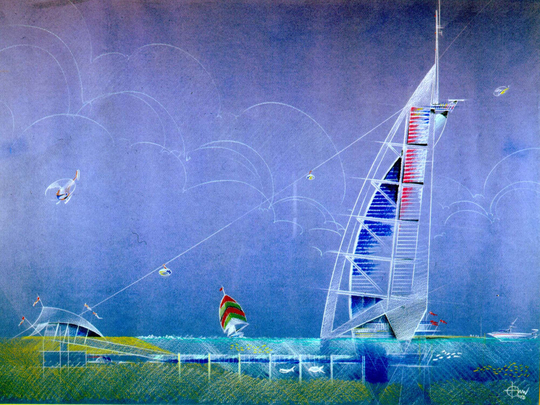
One of the first international engineering firms to take up residence in Dubai, Atkins’ influence on the built environment has evolved over the last half century from behind-the-scenes infrastructure consultancy to a high-profile portfolio of iconic structures.
“This year we are celebrating 50 years in the region,” says Tom Hasker, managing director — property at Atkins. “Originally, Atkins was largely recognised as an engineering and infrastructure brand, but over time we also developed our architectural business.”
Atkins’ UK expertise was first exported to the region in 1967 when a small team of engineers was sent to Kuwait to work on the country’s utilities infrastructure and road design. In 1979, client project demand saw the firm plant its feet permanently on Dubai ground with a new office and involvement in key infrastructure projects such as the dredging of Dubai Creek.
Says Hasker: “In the early days the region already had tremendous aspirations, but there wasn’t the supply of on-the-ground quality engineers, architects and contractors needed to realise the vision of the rulers.
“The people who worked here at the time always reminisce about the immense pressure they were under to make projects happen. However, in a lot of ways it was easier to deliver the big jobs back then as there were less of them, whereas these days everyone’s job is big and important, but just one of many.”
One of Atkins’ first transformational Dubai projects was, quite literally, a step change for the company, as Hasker explains: “In the early 80s the Dubai Municipality commissioned Atkins to design a reinforced concrete edge along the Deira bank of the creek to make passenger access on and off abra water taxis less of a challenge, and this resulted in the creation of the now familiar abra steps.”
In 1985, the team took on its first residential architectural commission, for the design and construction of a private villa on Al Wasl Road, and this led the way for more and more project wins, including the city’s original Standard Chartered Bank building, Dubai Police College and the Taj Palace Hotel.
Atkins’ turn to truly shine came in 1994 when it was engaged to design the city’s original hospitality icon, the Burj Al Arab, with the Jumeirah Beach Hotel and Wild Wadi Water Park also representing milestone project wins for the company.
Moving into the new millennium, the company continued to build bigger, taller and more complex structures with the Shaikh Zayed Road area home to a raft of Atkins-designed and engineered landmarks, including the first Address Hotel, The Address Downtown Dubai, along with the Princess Tower, 21st Century Tower, Chelsea Tower (now rebranded as the Al Salam Hotel Suites) and the Millennium Tower.
Its most recent high-profile accomplishment is the Dubai Opera, with Atkins managing the project from drawing board to delivery.
But its contribution to the city’s urban fabric isn’t always so immediately apparent, as Hasker explains: “Our involvement with Dubai Municipality spans years from creekside development to the Metro and in defining the areas that will promote Dubai’s growth and development. The Dubai Metro, with the Red Line the world’s longest driverless single metro line, was another hugely successful project for which we provided full multidisciplinary design and management of the civil works.
“We are also heavily involved with master planning for Al Maktoum International Airport in Dubai South.”
Urban rejuvenation is another area where Atkins is making its mark. “We see a lot more thought now going into development, rather than a desire to simply have trophy buildings, which don’t reflect the true urban fabric,” says Hasker.
“And there’s real interest in urban rejuvenation projects such as what Meraas has done with La Mer to bring new life and sensible development to existing areas,” Hasker adds. “Atkins is also lead consultant for the mixed-use waterfront Marsa Al Seef development on Dubai Creek, which is reactivating the real ‘old Dubai’.”
At the opposite end of the design spectrum, but also sited on the banks of the historic creek, Atkins’ work on the master plan for Emaar’s Dubai Creek Harbour community, in collaboration with RTKL, has a strong focus on digital innovation.
“Dubai is ahead of the curve compared to more established markets when it comes to digital infrastructure development, and that’s because a lot of the infrastructure here is so young,” says Hasker. “So, whereas not many established cities have the ability to master plan scaled communities such as Dubai Creek Harbour from scratch, we have the opportunity to leapfrog ahead. We have the view that within the next five years our business landscape, as well as Dubai’s physical landscape, will be dramatically different.
“The way that we deliver our services will reflect the massive shift towards digital engagement — or generative design — with technology that allows us to produce more efficient designs more quickly. And Dubai is embracing this far more quickly than other markets.”












